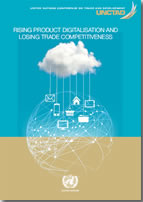
Digital economy has become the buzz word of the 21st century for some very good reasons.
In simple terms, digital economy can be defined as the sum of economic activities which function by means of digital technology, especially electronic transactions made using the internet.Some of the more known sectors where digital technology is widely used include: IT, Communications, Fina financial services, retail services and health services. But apart from these services sectors, which have been largely digitalised and known as e-services, manufacturing sector is now being increasingly supported by the digital technology.
This growing digitalisation of manufacturing products is creating new challenges for the developing and the least developed countries (LDCs).
This paper estimates the shares of different countries in crossborder e-commerce and highlights the losing trade competitiveness of developing countries and LDCs in digital products.
It further estimates the impact of WTO permanent moratorium of zero custom duties on Electronic Transmission (ET) products using SMART simulations.
The results show that the imports of ET products will rise further in most of the developing countries making them net importers, with adverse implications for tariff revenues. However, the moratorium will not affect the imports of the developed countries but increase their exports.
The paper highlights that with the rise of additive manufacturing (3D printing) the future ET products are still unknown.
There is a need for developing countries to develop their national e-commerce sectors through digital industrialisation policies.
For designing national digital industrial policies that match their existing level and pace of digital development, countries need to preserve the policy space in the WTO.



